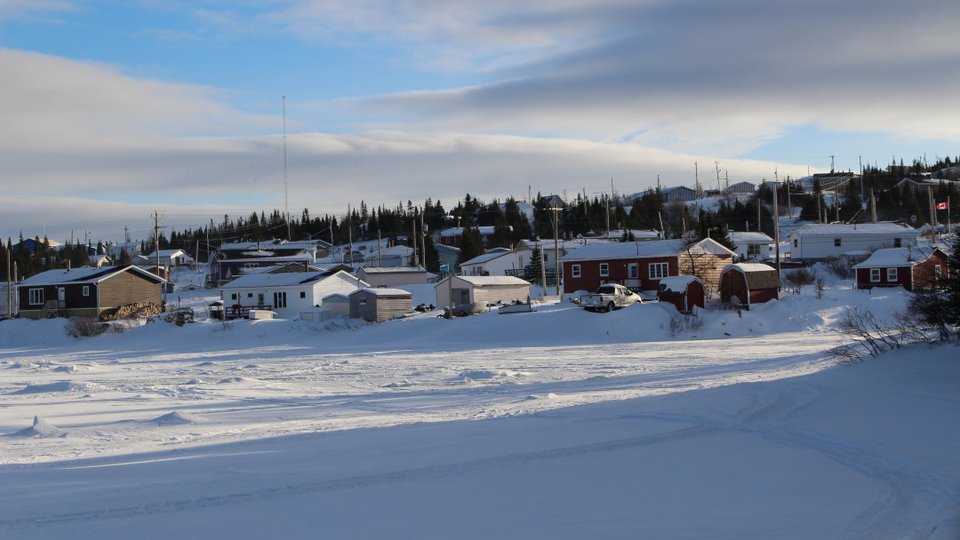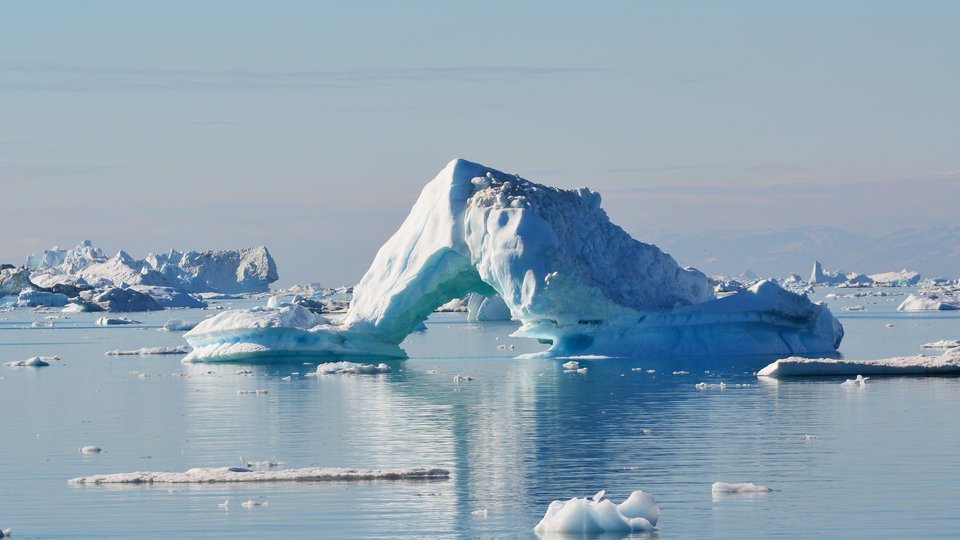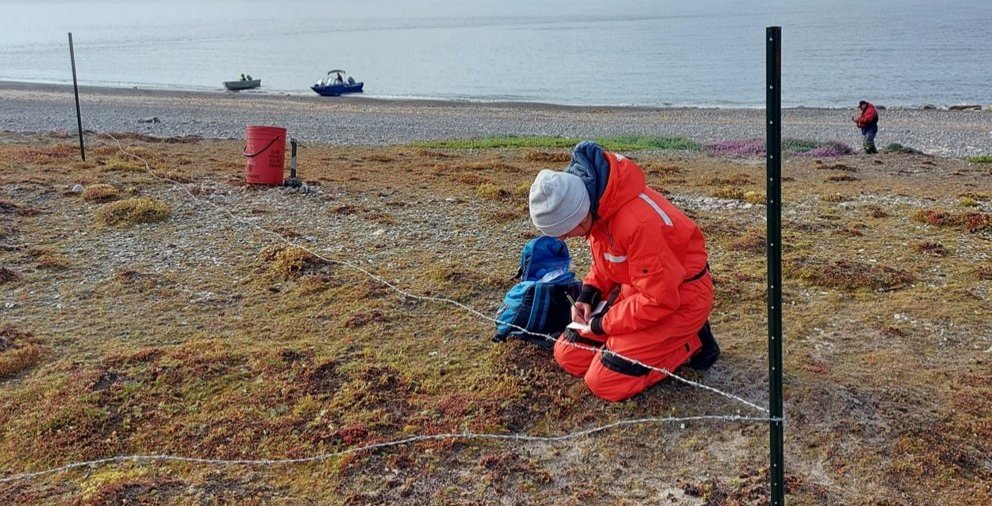
Carefully stepping over a strand of barbed wire, George Natawapineskum approached the pile of rocks with a pungent smelling concoction in hand. He slathered some of the rocks with the mixture of fish-scented commercial black bear bait and fryer grease before piling a few additional stones on top to preserve the smell and protect it from rain and snow. The research site, set up in a remote part of Eastern James Bay, is designed to attract polar bears by scent—while not providing a food reward—to collect data about them through non-invasive methods.
Natawapineskum is Cree Trappers Association and Eeyou Marine Region Wildlife Board local officer for Wemindji, Quebec, and his work is part of an effort to learn more about the region’s polar bear population. In recent years, community members in the region noticed more polar bears and also more human-bear conflict—including an incident where a polar bear was killed—so they wanted to learn more.
“There’s been more sightings,” says Natawapineskum. “There was a conflict [with a] polar bear a couple years back in one of those campsites on the islands… there’s two camps there and the polar bear was going back and forth, and people were in there. They tried to scare it away, but it wouldn’t go away, so they had to put him down.”
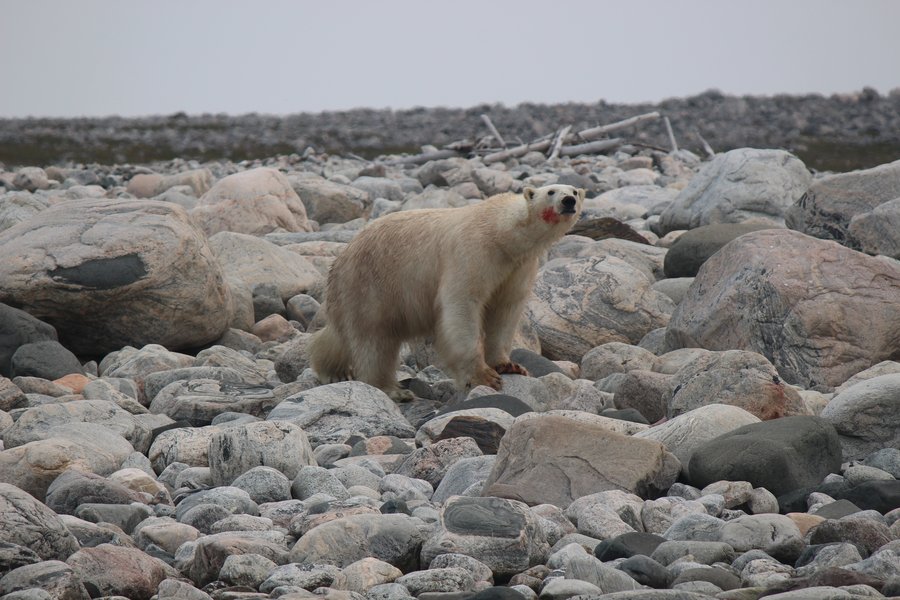
Photo: Alexandra Langwieder
The research project is a partnership between Cree land stewards and university researchers to co-create knowledge about polar bear populations in the Eastern James Bay area, including gathering information about the bears’ abundance and changing distribution. Community members wanted to ensure non-invasive methods were used for data collection, so the community-led project utilized hair snares and camera traps.
Results from the study were published in a 2023 FACETS article, “Community-led non-invasive polar bear monitoring in the Eeyou Marine Region of James Bay, Canada: insights on distribution and body condition during the ice-free season.”
James Bay is home to the world’s southernmost polar bears—and human communities
James Bay is located in the southern part of Hudson Bay, and is surrounded by Nunavut, Ontario, and Quebec. It is located on the southern edge of polar bears’ range, and bears in this area are facing a rapidly changing environment. The polar bears here are part of the Southern Hudson Bay subpopulation, one of 19 polar bear populations around the world.
Polar bears in James Bay live in a fairly unusual environment for polar bears since there is a boreal forest with trees in the southern part of the region. Polar bears here eat the Arctic-associated foods people commonly think of, such as ringed seals, bearded seals, and even beluga, caribou, and seabirds. But they also potentially have access to food from the boreal forest—from beavers to black bears to moose.
“Indigenous communities across the Arctic have been calling for non-invasive methods or have been calling at least for less handling of bears because of concerns for their well-being, but also because of very deep and important cultural values about the way animals should be treated."
These polar bears face one of the longest fasting periods of any polar bear, with a period of four to five months when the bay is free of ice. During this time, the bears stay on land as they wait for Hudson Bay to freeze so they can go out and hunt for calorically-rich foods like the seals they can find out on the ice. When they are fasting during ice-free periods, polar bears can drop weight quickly—losing up to a kilogram per day.
As the world warms, the fasting period bears in the region face is growing. Studies have shown that between 1980 to 2012, the area’s ice-free period has increased by more than 30 days. The FACETS authors also noted studies have found that the body condition found on polar bears that were examined along the Ontario Hudson Bay coast has declined, though they note this has “not yet been found to impact survival or population size.”
In Southern Hudson Bay’s Eastern James Bay, the Eeyou Marine Region is home to a number of Cree communities that partnered on this project to learn more about polar bears in the region. Partners include Cree communities in Waskaganish, Eastmain, Wemindji, and Chisasibi, along with Eeyou Marine Region Wildlife Board, Cree Trappers’ Association, and regional wildlife management organizations. Members of these communities have noticed changes in the number of polar bears they have seen in recent years, as well as where they have seen them.
“From the things that people have told me and from the things that I’ve been reading, coastal Cree communities have been using the coastal landscape for generations and generations, and there hasn’t necessarily been a lot of interaction with polar bears through that time,” says Alexandra Langwieder, a PhD student at McGill University who is working in the Northern Wildlife Knowledges Lab. She is one of the co-authors of the FACETS paper, along with Natawapineskum and others. “But then more recently, in the last decade or so, community members started reporting a lot more polar bear interactions, polar bears at their camps, polar bears in places where they weren’t being [seen] or hadn’t been seen before.”

Photo: Alexandra Langwieder
She says these sightings resulted in curiosity about what was happening with the polar bears, how many were in the area, where they were located, and what their role was in the James Bay ecosystem. Community members were also concerned about the increasing numbers of conflicts and encounters in the region, particularly at hunting camps and other sites where people may be present. While the communities do not traditionally hunt polar bears, occasionally one will be killed to protect human life.
Natawapineskum’s community of Wemindji is on the east coast of James Bay. Each community in the region has an officer—like Natawapineskum—who works with the Cree Trappers Association and the Marine Region Wildlife Board to monitor wildlife, including polar bears.
“We’re the eyes and ears for the Eeyou Marine Wildlife Board,” Natawapineskum says. “That’s how I got started with the polar bear. We monitor polar bears and all the wildlife.”
He says in addition to seeing the bears himself, community members also share information when they spot a polar bear or signs of a bear. “When they see a polar bear or polar bear tracks, they let us know,” he says. “They let me know so I can do the report on where it’s been sighted, how big it was, and I get pictures from the land users [to include].”

Photo: Alexandra Langwieder
Collecting data non-invasively
While community members wanted to learn more about the local polar bears, they wanted to make sure the research methods used were non-invasive due to the community’s ethical concerns.
Some methods of polar bear research involve chemically immobilizing animals, such as darting them tranquilizers, and examining the animals in a hands-on way. These methods often involve taking skin and blood samples, as well as detailed measurements, and affixing a collar which can remain on the animal for a couple years or so before falling off.
Mark-recapture studies are also used, sometimes examining the same animal again for comparison, though these studies often have a gap of many years between data collections. However, these methods are not always supported by local communities. The authors of the FACETS article wrote that Nunavut’s government “has withdrawn their support of invasive polar bear research methods except in certain circumstances.”
“Indigenous communities across the Arctic have been calling for non-invasive methods or have been calling at least for less handling of bears because of concerns for their well-being, but also because of very deep and important cultural values about the way animals should be treated,” Langwieder says.
For these reasons, the researchers opted to use hair snares and camera traps to collect data. These methods are commonly used for studies involving grizzly bears and black bears, but they are very rarely used with polar bears. However, in 2013, two studies were published using these data collection methods to gather information about polar bears, including a paper focusing on polar bear presence at subsistence-hunted whale carcasses, and another study at M’Clintock Channel.
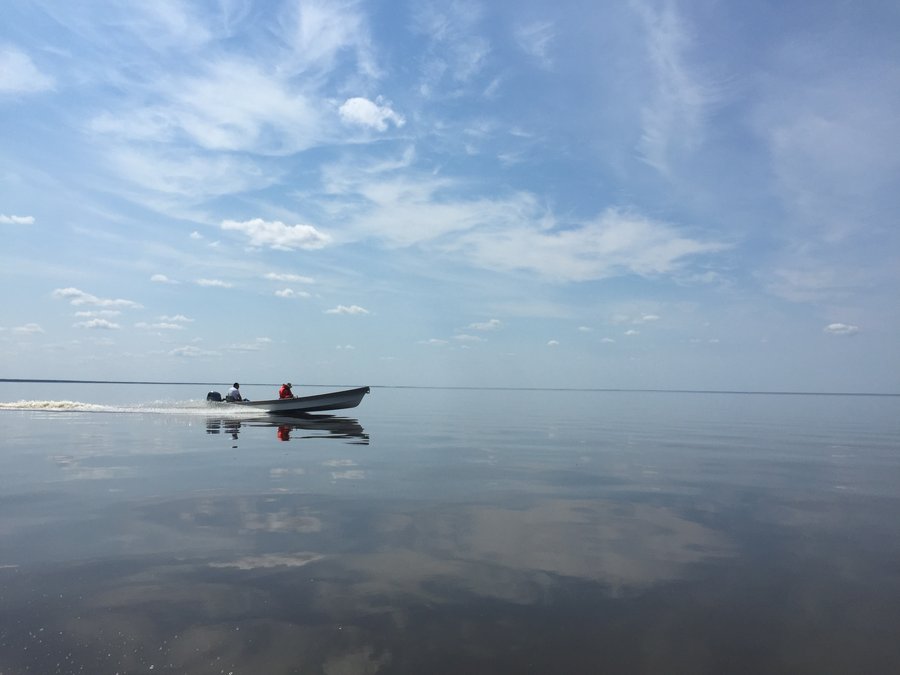
Photo: Alexandra Langwieder
The FACETS authors speculate these methods may not be commonly used with polar bears since their territory is so vast and difficult to access. It also requires local experts to lend their expertise to help teams travel safely to collect the data from remote sites, whether on land, ice, or water.
Eastern James Bay has difficult-to-access coastal terrain, but with the support of local communities, the research team was able to collect data non-invasively. The team set up 37 sampling stations across a 400 km stretch of the Eeyou Marine Region, along a north-south gradient. The Eeyou Marine Region has more than 1,300 islands located within the bay, with more than 95 per cent of them under one square kilometer in size. The largest island is Charlton at 315 square kilometers, followed by two other large islands, North Twin (158 sq km) and South Twin (77 sq km).
Sampling stations were set up on offshore and nearshore islands, along with four mainland locations. On the mainland, the stations were placed in areas away from human activity, such as hunting camps, since they did not want to bring the bears to areas where they may find conflict with people.
At each site, steel posts were placed in a triangle configuration 10 meters apart, with a strand of barbed wire stretched half a meter off the ground, connecting the posts. The scented bait in the middle served as an attractant for polar bears, while cameras were rigged to collect images. The sites lured bears in, and sometimes curious bears would bend the posts while they were investigating. Once, a bear even snapped a strand of barbed wire.
During the eight-week study period in the summer of 2021, local community members used boats to travel to the sites every two weeks to retrieve samples, swap out memory cards, and refresh the scented bait to continue attracting bears. They also looked for bears and denning locations on their trips to the sites. The study was set to take place at a time when the bay would be free of ice and food would be in shorter supply, so they could assess the bears’ body condition.
The research team gathered 118 samples of polar bear hair, along with thousands of photographs. Bears visited 14 of the 37 stations during the eight-week period. Most of the bears they detected were individual bears, though there were also a few family groups spotted. Most of the bears were detected on islands located far from the mainland.
The team used the images from the cameras to learn not only where the bears were spotted, but also to assess how healthy they looked. The study authors noted that most of the bears’ body condition was “average to above average.” This was important, they noted, writing, “body condition decline is among the first indicators of climate change-related habitat loss in polar bears and can play a determining role in future reproduction and survival.”
The hair samples obtained from the snares will be further analyzed, and researchers are conducting genetic and stable isotope analyses on the samples. These techniques can reveal a lot of information about bear genetics, as well as diet.
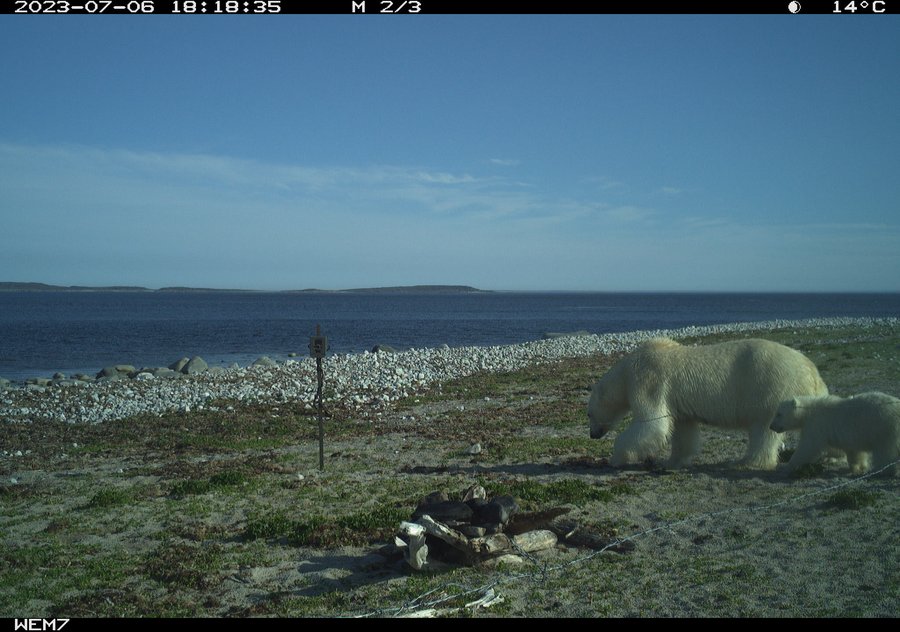
Photo: Alexandra Langwieder
“Through the hair samples we get really great information about polar bear genetics so we’re able to ID individuals using their genotypes,” Langwieder says. She notes they use the root of the hair to analyze the genotypes, and the rest of the hair is used to study their diets through stable isotope analysis, which tells researchers what level on the food chain the bear is feeding on, along with whether the food is terrestrial or marine.
“That sort of differentiation—marine versus terrestrial—is really important for polar bears because [if] polar bears [are] eating primarily terrestrial food, it’s really quite bad for their body condition and future survival,” Langwieder says.
The researchers can also learn how many individual bears the hair came from. Samples are sent to a lab for polar bear genotyping, and researchers compare the results with other databases to see if the bears that left their hair in James Bay were previously handled by researchers in other places, such as Ontario or Western Hudson Bay. They can use this information to learn more about how far these bears might be traveling. Since the bears in James Bay are fairly isolated from other polar bears, researchers also want to learn if it is a genetically distinct population.
While these non-invasive techniques used in James Bay had only been used on polar bears a few times before the study, Langwieder thinks these methods of studying polar bears through community-led, non-invasive efforts can be very useful on future projects.
“Our experience in James Bay has shown that this method is an effective way to gather really valuable information that was not possible to gather in any other way,” Langwieder says. “It can deliver this information while also engaging a huge number of community members in a way that the project is the community’s.”

